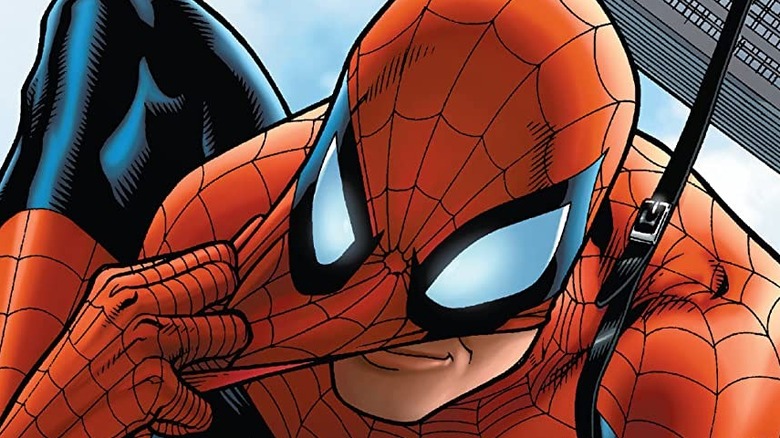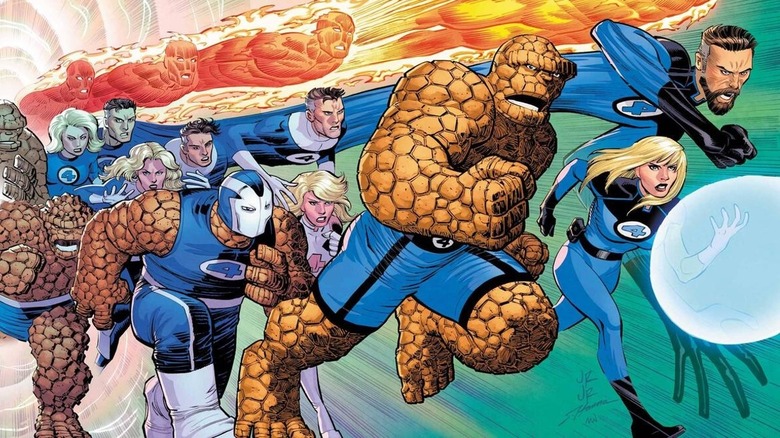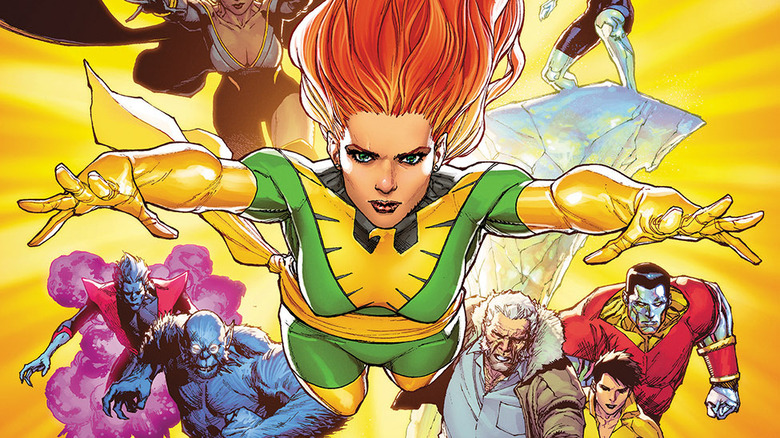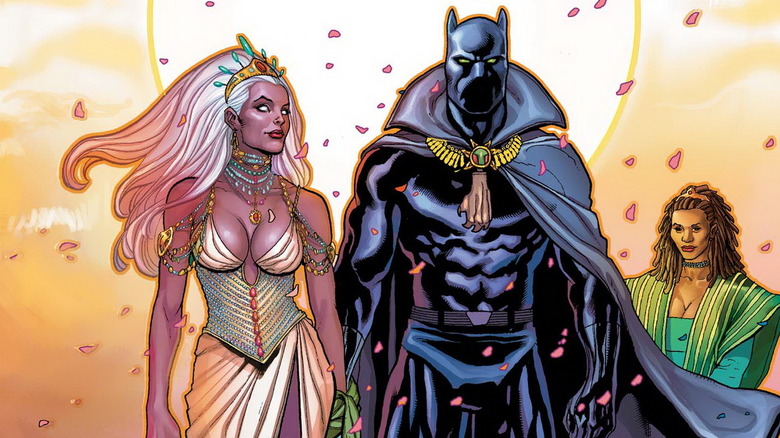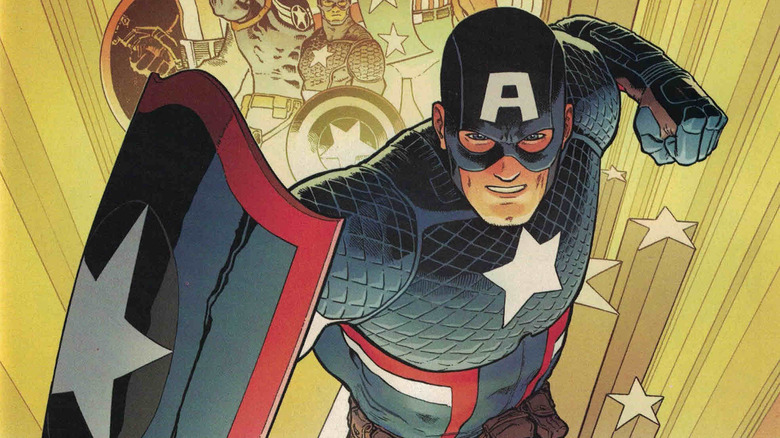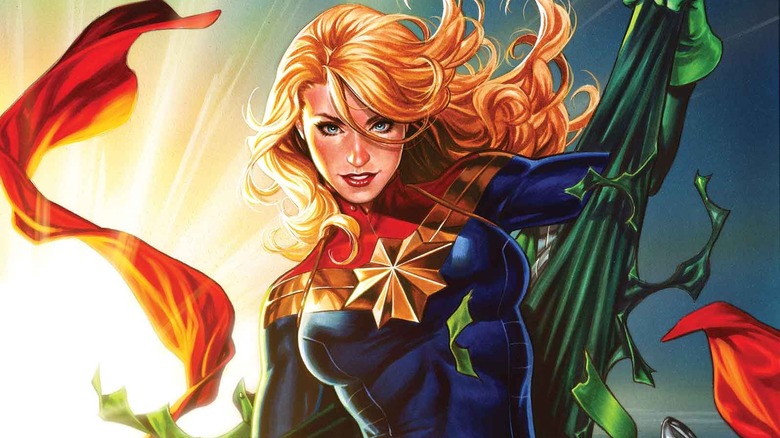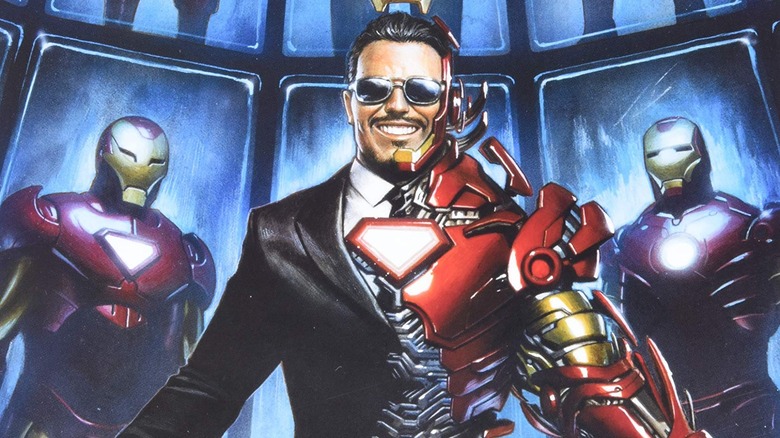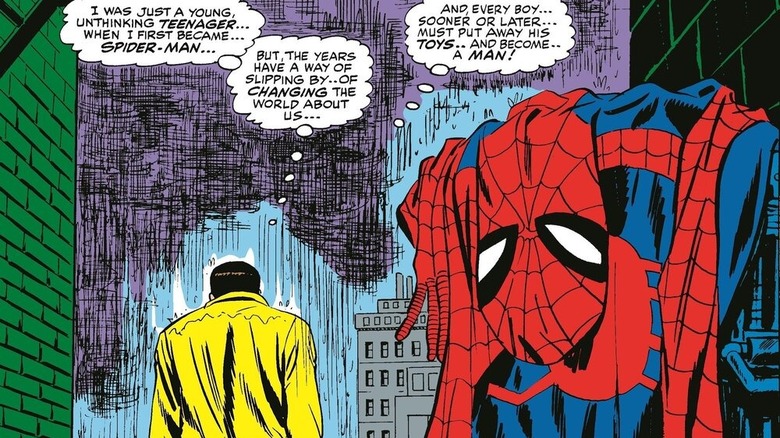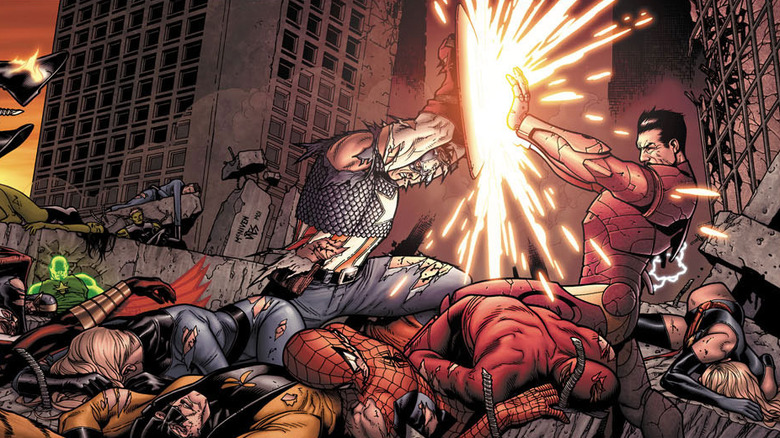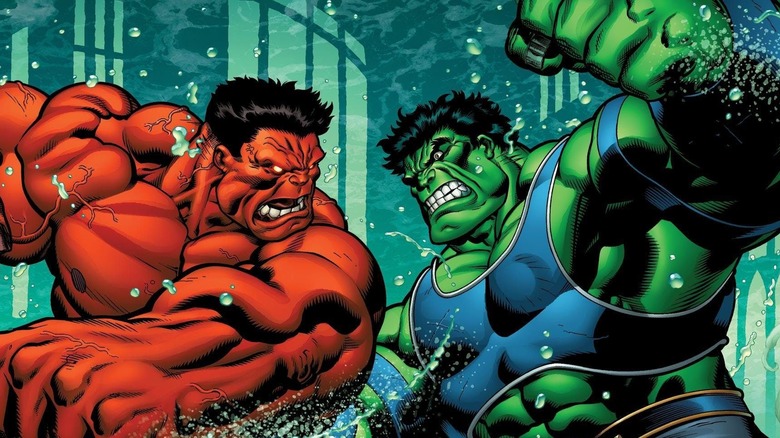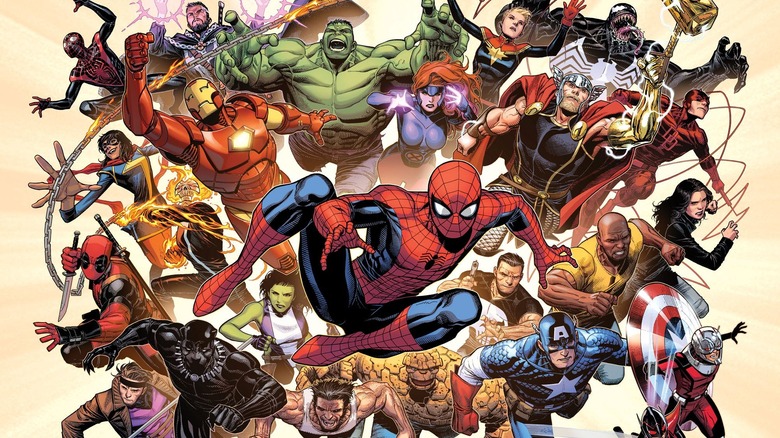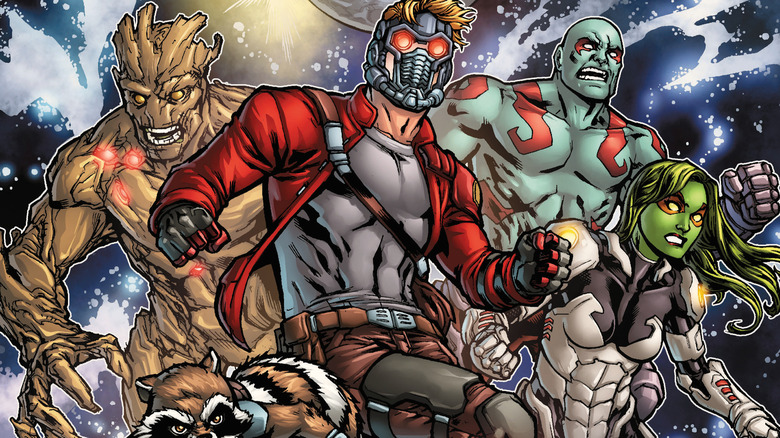Things Every Marvel Superhero Has In Common
One of the greatest strengths of the Marvel Universe is how unique many of their heroes are. But when a company's characters have been in constant publication for decades, such never-ending storytelling will inevitably result in a few common threads from time to time. Whether it's a story trope that's been repeated over time, or some rule of the industry that has stuck around long enough to impact multiple characters in the same way, many of Marvel's superheroes have aspects in common.
Some rules have changed over time; Stan Lee's insistence that the company's characters not have sidekicks, for instance, was eventually dropped. Then there's the matter of authorship: in the '60s and '70s, it was nearly impossible to find a popular Marvel character not bearing the signatures of some combination of Stan Lee, Jack Kirby, or Steve Ditko; in the decades since, you'd have an equally unlikely chance of finding a creator who didn't grow up worshipping that trio — and is likely to follow certain elements of a time-tested, beloved blueprint.
Below is a breakdown of the things every Marvel character has in common, with rare exceptions. They have become the essential truths of superhero storytelling, and they are key reasons fans love these characters so much.
They will always return to their status quo
In many ways, this is the first truth of mainstream superhero storytelling — or sitcom writing, or many cartoons, or most anything pop culture-related that hopes to keep audiences interested in core characters week after week, year after year. No matter what changes are made, the characters will always revert back to their core elements and a certain status quo.
In the Marvel universe, such resetting is a byproduct of the company's many creators telling superhero stories non-stop for decades; whenever new writers and artists begin work on a long-established character or team, they don't want to be forced to piggyback off someone else's plot developments — more often than not, they want to work with the key versions of these heroes, the ones that they grew up loving.
Although many comic book storylines will temporarily alter the status quo to explore something different or create consequences, it always changes back. The Onslaught crisis in the '90s, for instance, separated the Avengers into their own separate universes via the "Heroes Reborn" event, but they eventually returned to each other. Similarly, 2008's "Secret Invasion" resulted in the "Dark Reign" of the villainous Norman Osborn, HAMMER, and their "Dark Avengers," but that was eventually undone with "Siege" a couple years later.
This recurring-reset element of comic book creation is perhaps easiest to see with the Fantastic Four, Marvel's first superheroes. Most famously, the FF consists of Mr. Fantastic, the Invisible Woman, the Human Torch, and the Thing. No matter how many times one of them leaves the team, retires, or dies, now matter how many times someone else joins the team, the FF will always revert back to that foundational membership eventually, because those characters are the Fantastic Four. That is the status quo they will always return to, and the starting point most adaptations embrace on page one.
They've been resurrected at least once
One of the side effects of continuous storytelling is a difficulty in raising or changing the stakes and keeping the stories engaging. Even if a creative team manages it in one story, they have to do it all over again in the very next issue the month after. Because of this, it's pretty common for major comic book "events" to use the death of a popular character to sell the seriousness of a situation, drive home how dangerous a villain is, or give the story a sense of consequence.
Unfortunately, that only works for so long, as the medium's tendency to revert to its classic mission statement ultimately means that any character who dies in the heat of battle will return before all that long. Some characters, like Jean Grey, may stay dead longer than others or die multiple times — but they will almost always come back, whether it's through a literal resurrection or not.
Steve Rogers, for instance, famously "died" at the end of 2006's "Civil War," but then was discovered lost in the time stream roughly two years later in "Captain America: Reborn." Thor and all of Asgard died in 2004's comic book version of "Ragnarok" ("Thor" #80 to 85) but — gasp! — they returned just in time for J. Michael Straczynski to relaunch the title in 2007's new "Thor" #1. So, if your favorite superhero ever "dies," don't let it get you too bummed out.
They aren't allowed to get or stay married
Another common casualty of the constant cycle of comic book storytelling is marriage. Many of Marvel's heroes have been married at some point, but very few of them stay that way.
Most of the time, this is a matter of practicality. After all, while it may be heartwarming to have a headliner like Spider-Man finally marry Mary Jane Watson, that then threatens to rob the writers of any ability to explore romances with other characters. Effectively, such permanence and stability takes away an important element of their storytelling toolbox, so it can only be maintained for so long.
Because of this, fans get stories like "One More Day," where Mary Jane and Peter Parker make a literal deal with the devil to save Aunt May's life, at the cost of their decades-long marriage. Similarly, Black Panther's marriage to Storm (from the X-Men") was annulled by Wakandan Priests after she chose to side with mutants (not Wakanda) during "Avengers vs X-Men" in 2012.
One of the only true exceptions to this rule has been Reed Richards and Sue Storm from the Fantastic Four — but that's because for the majority of their existence, they have been a married couple, and it has become a core identifier to the characters; as such, it is an element whenever they return to their status quo. Jessica Jones and Luke Cage's marriage has also lasted a long time, since 2006's "New Avengers Annual" #1, but many fans worry it's only a matter of time before a creative team decides to tell a separation story — if an when that happens, it would be interesting to see whether their marriage has similarly become a "status quo" identifier to which the characters would eventually revert.
They've gone evil at some point
Whether they were temporarily mind-controlled or had a simple-yet-evil change of philosophy, every Marvel superhero has gone evil at some point. Some heroes, like the Hulk, operate as villain fairly often, and everyone else has at least one story where they've joined "the dark side."
Captain America famously revealed that he'd "always" been a Hydra agent in Nick Spencer and Jesus Saiz's "Captain America: Steve Rogers" #1, though later issues revealed that his history had been altered by the cosmic cube, creating a variant of Cap that was eventually defeated after the original was restored. Jean Grey famously turned evil when she was possessed by the Dark Phoenix, and would have destroyed entire star systems if her lover Cyclops hadn't killed her first.
Speaking of the X-Men, until Magneto and Charles Xavier's philosophies grew more aligned in recent years, it was pretty common for the team's members to switch between the two sides. The opinions of characters change over time, things happen (like becoming temporarily corrupted by Apocalypse when he transformed one or more of them into one of his Horsemen), and alliances inevitably shift.
In case they had missed any, Marvel even had an event in 2014 called "Axis," in which the cosmic cube was used to flip the morality of everybody on the planet, turning all of its heroes into villains and vice versa. Tony Stark even managed to avoid the switch-back, remaining a villain for a time as the "Superior Iron Man."
They get more powerful over time
Serialized storytelling is pressured to constantly raise the stakes, resulting in ever-more-dangerous threats from increasingly powerful villains. Because of this, when Marvel's superheroes respond to those threats, rising to their enemy's challenges often necessitates an increase in power, even if it's unintentional.
Captain America is an easy example. When Stan Lee first brought him back in 1963's "Avengers" #4, he wasn't superhuman at all. He was simply a man that had been transformed to the peak of human conditioning by the formula — and it couldn't even keep him there, as Cap was required to spend most of his off time training if he wanted to retain what the serum had given him. In modern comics, however, the serum has gone from shortcut to superhuman ability-granter, reflected in the Marvel Cinematic Universe and depicted in "The Falcon and the Winter Soldier" Disney+ series.
While heroes like Hulk and the Thing have steadily gained strength over time, some power increases aren't so subtle. Carol Danvers, for example, originally gained her powers due to a broken alien machine in 1969's "Captain Marvel" #18 but lost them to Rogue as told in "Marvel Super-Heroes" #11. After a space adventure in "Uncanny X-Men" #164, however, Carol gained vastly superior "Binary" powers, which she subsequently lost and regained many times before finally keeping them for good as Captain Marvel.
If they had a secret identity, they probably don't anymore
When Iron Man first appeared in 1962, Tony Stark told the world that Iron Man was his personal body guard, and he hid his heart condition from everybody. Thor used to secretly transform into a human doctor named Donald Blake. The Avengers didn't know anything about each other's personal lives, and the X-Men's status as mutants and superheroes was hidden from even their parents, who believed they were all students at a prestigious prep school with a rigorous recruitment program.
Protecting those identities, at that time, felt like an important aspect of being a superhero; it was a cornerstone of the genre, but one that today simply doesn't matter like it once did. Though some new heroes, like Kamala Khan, will focus on secret identity-related stories in their initial adventures, it's nearly always a matter of time before they tell their closest loved ones, and the drama surrounding the secret disappears, even if their identity isn't technically public knowledge.
The MCU has widely dismissed the trope as well. Tony Stark announced he was Iron Man at the end of his first film, the Thor films have ignored the Donald Blake storyline entirely, and Spider-Man's identity was revealed to the world at the end of "Far From Home." In the comics, Spider-Man is one of the only superheroes that still keeps his identity secret — but even he has had a public identity in stories like 2006's "Civil War," when he agreed to the Superhuman Registration Act alongside Iron Man.
They've all decided to quit being a superhero at one point
Every superhero needs a break once in a while, even if they tend not to last very long. Whether it's because they've lost their powers, or simply the will to soldier on in a never-ending battle against evil, seemingly every superhero has taken a step back from their colorful careers at least once.
Spider-Man has done so several times, the most iconic of which came via 1967's "Amazing Spider-Man" #50, which was co-opted for Sam Raimi's "Spider-Man 2." Similarly, Tony Stark handed over the armor and identity of Iron Man to James Rhodes in "Iron Man" #170 in 1983, when Stark needed to take some time off when his alcoholism and other personal problems became too much to handle.
Even Steve Rogers has taken a step back, multiple times. After his "resurrection," he had Bucky continue working as Captain America so he could act as Director of SHIELD, and when his body was stripped of the Super Soldier Serum for a time, he did so again and asked Sam Wilson take up the shield in his stead. Similarly, when Thor became unworthy to wield Mjolnir in 2014's "Original Sin" event, he took a step back and started using the name "Odinson," while Jane Foster claimed Mjolnir and became the new "Thor" — a storyline that seems like to heavily influence the upcoming "Thor: Love and Thunder."
Each hero has fought every other hero, often multiple times
Every comics fan knows the trope: When two heroes meet for the first time, they almost always end up fighting due to some misunderstanding. Between these events and actual disagreements like 2006's "Civil War" and its 2016 sequel, "Civil War II," it's far more difficult to find characters who haven't fought than those who have.
As Marvel's two largest most popular teams, the Avengers and the X-Men are one of the easiest, most iconic examples. The two teams debuted in the same month of 1963, and in less than a year, their original rosters fought for the first time in "X-Men" #9. They fought again in "Avengers" #53 (the finale of a crossover "event" between the two teams), and again in the aptly-named 1987 miniseries "The X-Men vs. the Avengers." But perhaps their most famous fight was in the similarly-named 2012 event "Avengers vs X-Men," often abbreviated to "AvX."
After decades of continuous publication, just about every character combination has gone to the mattresses. It makes sense, because there are few things fans love more than asking sentences that begin with the words "who would win in a fight..." and there's an undeniable primal thrill in watching heroes fight each other, even if the reasons behind the fight aren't always particularly convincing. Such fights help answer questions and fan debates about who would be able to defeat whom, and they are ultimately one of the most helpful ways to figure out how heroes rank against each other in terms of things like strength or speed.
Every hero has at least one partner and villain with their exact powers
There are few things comics love more than giving heroes villains or partners with nearly their exact power set. It's a common trope that lets creators show off the characters' differences by highlighting the unique way each one uses these abilities. This is basically the appeal of "Spider-Man: Into the Spiderverse," and can be easily seen across both comics and their movie adaptations.
Take a look at the various Marvel movie adaptations. The first two major villains of Robert Downey Jr.'s Iron Man films built their own suits. Captain America fought the Red Skull and then the Winter Soldier, both of whom were also super-soldiers, and the second of which later became his partner. T'Challa and Killmonger were both Black Panthers during their final fight, "The Incredible Hulk" fought the Abomination, Ant-Man fought Yellowjacket, Wolverine faced off against a younger clone of himself in "Logan," and Spider-Man has fought Venom before and likely will again soon.
A good example in the comics is all the superhuman-strength drama surrounding the Hulk. There's his arch-nemesis, the Abomination — as well as the villain's successor "A-Bomb." Then there's Bruce's cousin Jennifer Walters (a.k.a. She-Hulk). General Thaddeus Ross became the Red Hulk in 2008's "Hulk" #1, and it wasn't long before his daughter Betty joined him as the Red She-Hulk. If that wasn't enough, Amadeus Cho, now known as "Brawn," became the "Totally Awesome Hulk" in 2015 — and the classic Hulk has had several children including Lyra (the Savage She Hulk) and Skaar, both of whom have almost limitless physical strength, just like dear ol' dad.
They've all been an Avenger
"And there came a day unlike any other, when Earth's mightiest heroes found themselves united against a common threat. On that day, they became The Avengers!"
Unlike the X-Men or the Fantastic Four, the only thing that links the Avengers is their determination to work together to protect the world. As such, literally any character with this goal is, has been, or will be an Avenger. In fact, it has reached the point where any general group image of Marvel's various superhero characters can nearly always double as an image of the team. When the world is threatened, everybody is an Avenger, a fact that 2019's "Avengers: Endgame" realized exceptionally in the film's finale.
The rule is a little trickier when it comes to official membership on the standing team in their ongoing comic books — but between the team's multiple titles and decades of publishing, it's become pretty true there as well. Members constantly came and went in the team's initial volume from 1963 to 1996, and subsequent series since then like "New Avengers" in 2004, "Uncanny Avengers" in 2012, and "All-New, All-Different Avengers" in 2015 were all created so they could, in part, feature popular characters who had never been on the team before.
If any Marvel superhero remains who hasn't already been a member of the Avengers, it's probably just a matter of time before that character is added to the roster.
Any of them could have a film or series announced at almost any time
When Marvel Studios first told the world in 2012 that they were making a "Guardians of the Galaxy" film, people were quite shocked. Even many long-time comics fans had no idea who the Guardians were, and suddenly they were getting A-list Hollywood treatment previously reserved for the likes of Spider-Man or Thor.
Now, a decade later, the Guardians are one of Marvel's most valuable and popular franchises. They have their own AAA video game title from Square Enix, and both "Avengers: Infinity War" and "Endgame" ultimately functioned more like a huge crossover between the two teams than they did as purely Avengers films.
History repeated itself in 2018 when Marvel announced its plans for an "Eternals" film, and though that movie doesn't appear to be the runaway success that "Guardians" was, it's yet another obscure addition to the MCU that nobody saw coming. Between these films, Hulu-original series like "M.O.D.O.K." and "Hit Monkey," and the dozen or so upcoming MCU projects on Disney+ and beyond, fans live in a world where a show or film featuring just about any character could be announced at any moment.
If someone from the late 1990s was told that some day, the lead singer of Thirty Seconds to Mars would star in a feature-film adaptation of the obscure Spider-Man villain "Morbius," they very wisely would not have believed you. These days, however, it's just another Tuesday in the MCU.
